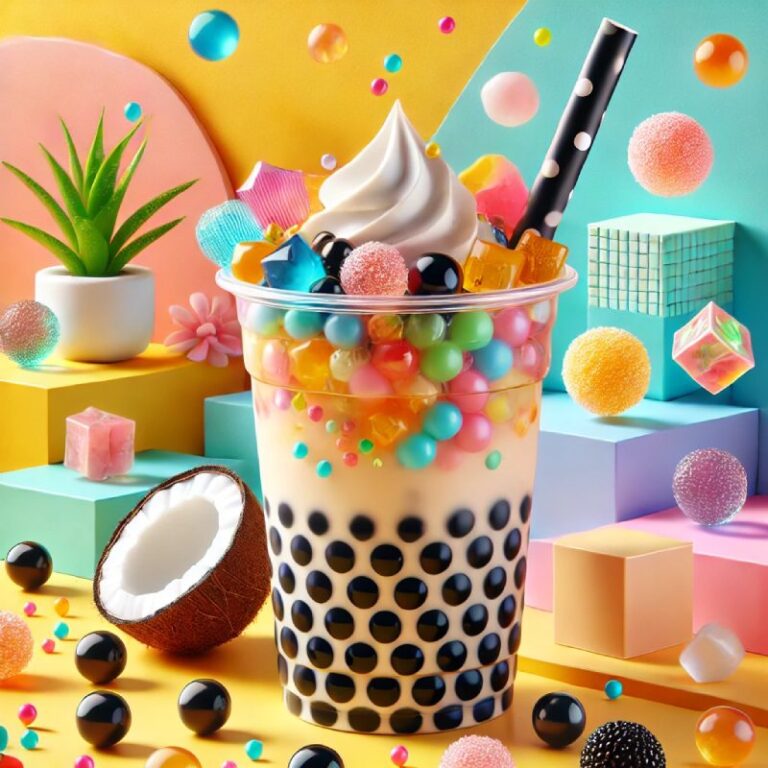

What are the little things in boba tea called? Get to know tapioca pearls, sago, popping boba, and jelly toppings in this fun guide!
Tapioca pearls are the most well-known and beloved toppings in boba tea. Their chewy texture and subtle sweetness make them the perfect companion to milk teas and fruit teas alike.
Tapioca pearls, often just called boba, are small, round balls made from cassava starch. They start as white, hard pellets but turn into dark, chewy pearls when cooked, thanks to the addition of brown sugar or caramel syrup.
The process begins by mixing tapioca starch with boiling water to form a dough, which is then rolled into tiny spheres. These pearls are then boiled until they reach the perfect chewiness and are often soaked in a brown sugar syrup to enhance their flavor.
Tapioca pearls add a unique, satisfying chew to every sip of boba tea, creating a drink-and-snack experience in one. Their slightly sweet flavor pairs well with a variety of teas, making them a versatile topping for classic milk teas and refreshing fruit blends.
While the traditional black tapioca pearls are the most common, there are also smaller versions used in certain drinks. Some variations include golden boba, which has a lighter caramel-like taste, and colorful boba, which adds a fun visual appeal to bubble tea.
Unlike chewy tapioca pearls, popping boba adds an unexpected burst of flavor to every sip of boba tea. These little things in boba tea are filled with fruit juice, creating a fun and refreshing twist on traditional toppings.
Popping boba consists of small, juice-filled spheres made using a process called spherification. Each one is coated in a thin, seaweed-based membrane that gently pops when bitten, releasing a burst of fruity flavor.
The magic behind popping boba lies in its outer shell, which is created through a reaction between calcium and sodium alginate. This reaction forms a delicate membrane around the fruit juice, allowing it to hold its shape until it bursts in the mouth.
Popping boba is available in a variety of fruit flavors, including mango, lychee, strawberry, passion fruit, and pomegranate. These flavors complement fruit teas, slushies, and even yogurt-based drinks, making them a popular choice for those who enjoy a refreshing twist.
Popping boba offers a lighter, juicier experience compared to the chewy texture of tapioca pearls. It is an excellent alternative for those who prefer a burst of sweetness in their boba tea rather than the traditional chewiness of classic boba pearls.
Jelly toppings are another fun addition to boba tea, offering a softer chew compared to traditional tapioca pearls. These little things in boba tea come in various shapes, colors, and flavors, enhancing both the texture and taste of the drink.
Boba tea shops offer a variety of jellies, including coconut jelly, lychee jelly, grass jelly, and coffee jelly. Each type brings a unique flavor and texture, making them a great alternative to tapioca pearls or popping boba.
Most jellies in boba tea are made using agar or konjac, plant-based ingredients that create a firm yet slightly bouncy texture. These jellies are cut into strips, cubes, or stars and soaked in flavored syrup to enhance their sweetness.
Jelly toppings add an extra layer of flavor and chewiness without being as dense as tapioca pearls. Their smooth texture and fruity or herbal taste make them a perfect match for milk teas, fruit teas, and slushies.
Lychee and coconut jelly go well with fruit-based teas, while coffee jelly is a great match for milk teas and iced coffee drinks. Grass jelly, with its mild herbal flavor, pairs well with brown sugar boba tea for a balanced, refreshing sip.
Sago pearls are another variety of little things in boba tea, offering a smaller and softer texture compared to traditional tapioca pearls. These tiny pearls absorb the flavor of the drink, making them a great option for those who enjoy a lighter and more delicate chew.
Sago pearls are made from the starch of the sago palm and resemble miniature versions of tapioca pearls. They have a translucent appearance and a softer consistency, making them a popular choice in many Asian desserts and beverages.
While both sago and tapioca pearls add texture to boba tea, sago pearls are much smaller and have a more delicate bite. They also tend to soak up the flavors of the tea more quickly, providing a smoother and less chewy experience.
Sago pearls are often used in traditional Asian desserts and coconut-based drinks, giving them a nostalgic appeal. Their light texture makes them ideal for pairing with creamy milk teas or refreshing fruit blends.
Choosing between sago and tapioca pearls depends on personal preference and the type of drink. If you enjoy a chewy, satisfying bite, tapioca pearls are the way to go, but if you prefer a lighter and more subtle texture, sago pearls are a great alternative.
Boba tea is known for its fun textures, and the little things in boba tea play a huge role in making each sip an experience. Whether you prefer the classic chewiness of tapioca pearls, the juicy burst of popping boba, the soft texture of jellies, or the delicate feel of sago pearls, there is a perfect topping for everyone.
Each type of boba topping brings a unique texture and flavor that can completely transform a drink. Experimenting with different toppings allows you to find the perfect combination that matches your taste preferences.
The best topping depends on whether you enjoy chewy textures, fruity bursts, or smooth and silky add-ins. Traditional milk teas go well with tapioca pearls or sago, while fruit-based teas pair beautifully with popping boba and flavored jellies.
Having the right equipment is key to creating consistent and delicious boba drinks. For high-quality boba tea machines, custom cups, and all the supplies needed to run a successful bubble tea shop, visit BubbleTeaology.
Next time you order or make boba tea, consider trying a different topping to enhance your drink experience. Whether you stick with the classic or go for something new, the little things in boba tea make every cup exciting and unique.
Learn more about Bubble Tea and why it’s a global phenomenon.
Q: What are the little things in boba tea called?
A: The little things in boba tea are called toppings, and they include tapioca pearls, popping boba, jelly toppings, and sago pearls. Each topping offers a unique texture and flavor, enhancing the overall drinking experience.
Q: Are tapioca pearls and popping boba the same thing?
A: No, tapioca pearls are chewy balls made from cassava starch, while popping boba are juice-filled spheres that burst when bitten. Tapioca pearls have a denser texture, while popping boba provide a fruity explosion of flavor.
Q: What is the difference between sago pearls and tapioca pearls?
A: Sago pearls are smaller and softer than tapioca pearls, giving them a lighter, more delicate texture. Tapioca pearls are larger, chewier, and often sweetened with brown sugar syrup.
Q: Which boba toppings are best for fruit tea?
A: Popping boba and flavored jellies pair best with fruit teas because they enhance the fruity flavors with their own juicy or chewy textures. Lychee jelly, mango popping boba, and coconut jelly are popular choices.
Q: Can I mix different toppings in my boba tea?
A: Absolutely! Many boba tea lovers mix multiple toppings, such as tapioca pearls with coconut jelly or popping boba with fruit-flavored jelly. Mixing toppings creates a more exciting and layered texture in each sip.
Copyright © 2023 BubbleTeaology. All Rights Reserved.